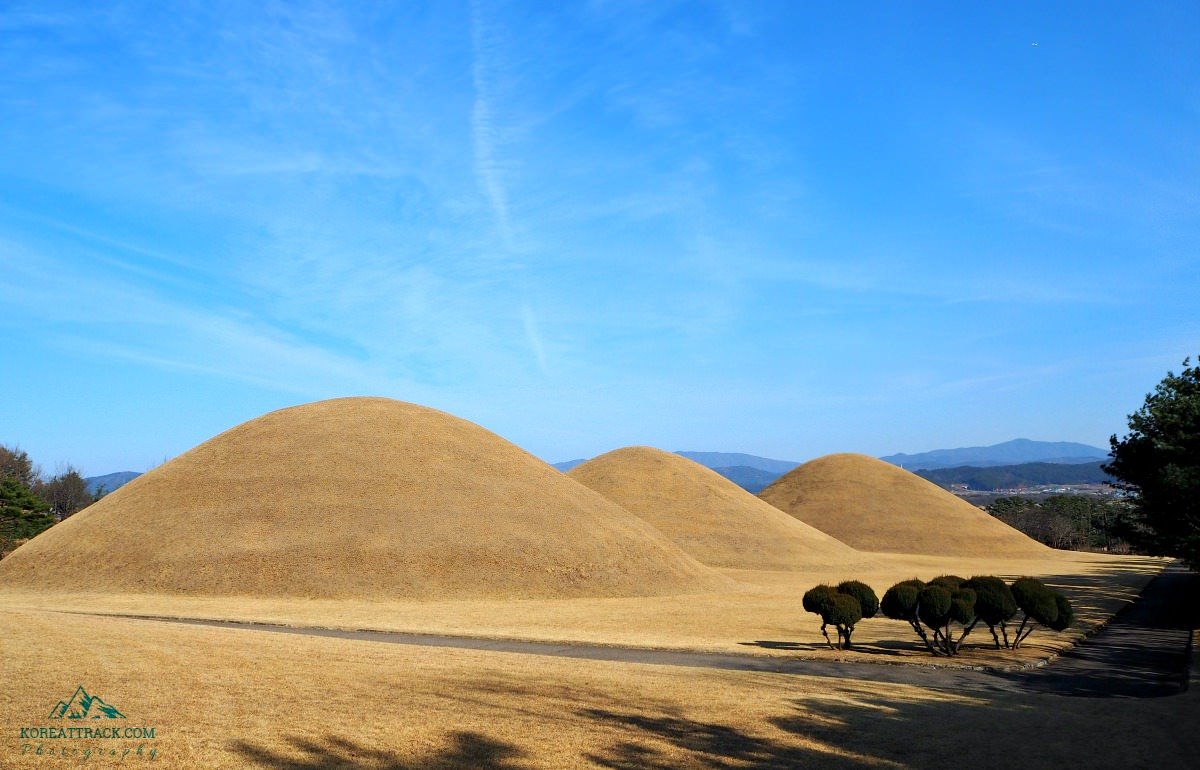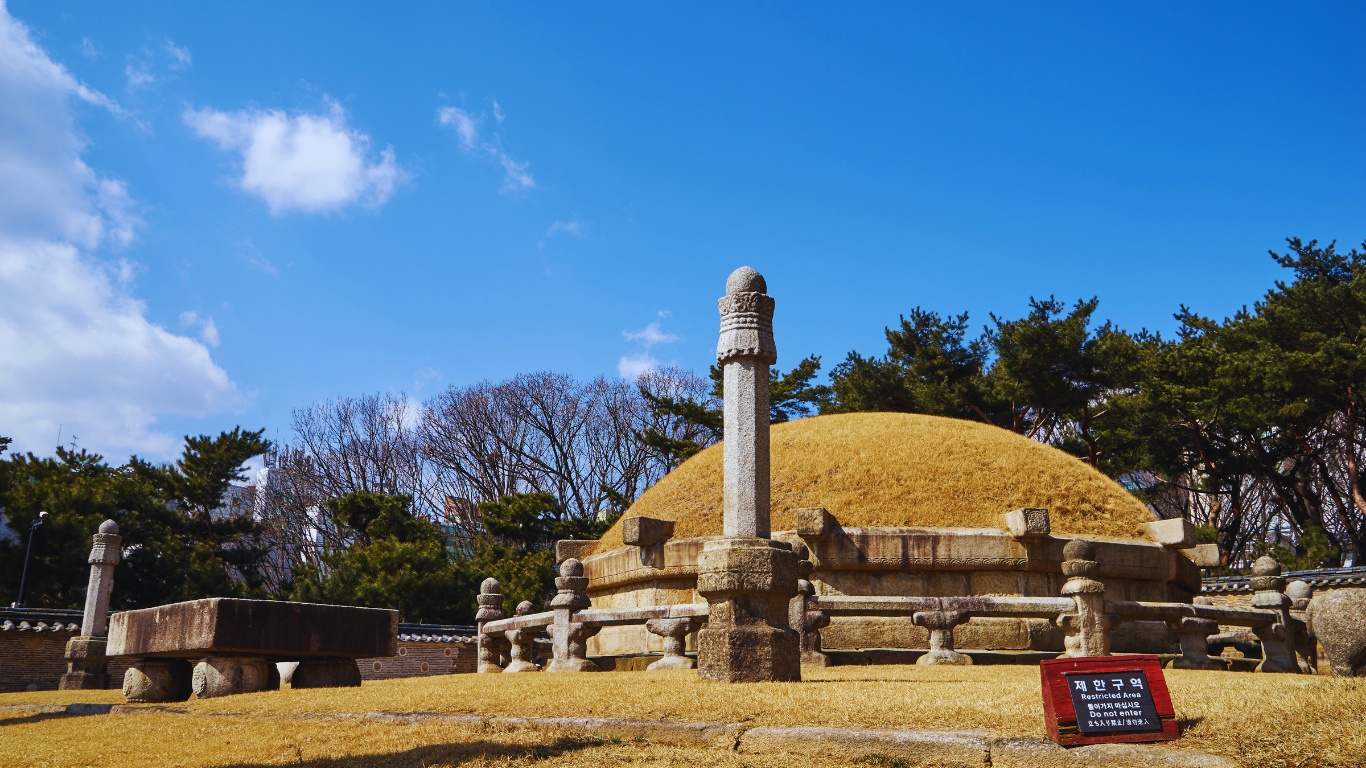Yeonghwiwon and Sunginwon Royal Tombs
 Yeonghwiwon and Sunginwon Royal Tombs - back view of the tomb
Yeonghwiwon and Sunginwon Royal Tombs - back view of the tombYeonghwiwon and Sunginwon Royal Tombs
Yeonghwiwon and Sunginwon Royal Tombs are burial mounds designated for princes and accompaniments. The social hierarchy was extremely stringent throughout the Joseon Dynasty (1392-1910). That thinking has influenced the way the existing burial places are designed.
Being a meaningful part of Korean legacy, these royal tombs were designated as Historical Sites in 1991. Its designation has all the more have been attracting visitors, especially during the Fall season, when the leaves are colorful.
You will notice that the tombs for queens and kings called 'neung' are wider and more elegant. On the other hand, the burial places for princes and attendants called 'won' are less sophisticated.
 Yeonghwiwon and Sunginwon Royal Tombs - entrance gate and view of the tombs area
Yeonghwiwon and Sunginwon Royal Tombs - entrance gate and view of the tombs area Yeonghwiwon and Sunginwon Royal Tombs - close-up view sculpted lantern and figures
Yeonghwiwon and Sunginwon Royal Tombs - close-up view sculpted lantern and figuresBrief Background
Yeonghwiwon houses the burial place of Queen Consort Sunheon (1854-1911), King Gojong's courtesan, while the Sunginwon is for King Yeongchin's child, Ijin (1921-1923).
The composition of the two burial places is comparable; however, Yeonghwiwon is larger than Sunginwon.
When entering the burial grounds, you will notice the red gate (the red color denoting holiness). Beyond the red gate is a sacrificial structure where the memorial rites were performed.
Behind the sacrificial structure is the royal burial place. On the eaves of the sacrificial building are stone sculptures called 'japsang,' which are carved into the shapes of animals such as monkeys and are thought to exorcise evil spirits.
There is a pavilion beside the sacrificial building where the tombstone lies. The headstone shows who was buried on the mound. The stone figures protecting the king's burial place are unforgettable.
 The ceremony hall for memorial days' activities
The ceremony hall for memorial days' activities Ceremonial Hall and Stele Pavilion (houses the stone with descriptions about the dead)
Ceremonial Hall and Stele Pavilion (houses the stone with descriptions about the dead)A sacrificial structure called "jasil" is now utilized as an upkeep office and deserves checking out. The eaves, latticework, and wood floor are so well maintained that visitors can get a genuine sensation when walking through the properties.
When the leaves turn technique color, Yeonghwiwon & Sunginwon boast remarkable views in the fall. The promenades and the stonewalls of the entryway are gorgeous. Its enjoyable and peaceful atmosphere attracts all sorts of curious visitors, including families, individuals, and lovers alike.
Yeonghwiwon and Sunginwon tombs were once known as Hongneung as Queen Myeongseong, the very first spouse of King Gojong was interred here. The grave was relocated to Geumgok-dong in the city of Namyangju in 1919, following the death of King Gojong.
Since then, the site has been called Yeonghwiwon and Sunginwon. Apart from its historical significance, the plant and stunning surroundings here have always attracted curious visitors and sightseers.
About Queen Myeongseong
![An image of Queen [Empress] Myeongseong queen empress myeongseong traditional painting image](https://www.koreattrack.com/images/queen-empress-myeongseong-traditional-painting.jpg) An image of Queen [Empress] Myeongseong
An image of Queen [Empress] MyeongseongQueen Myeongseong, also known as Empress Myeongseong, was the wife and queen consort of Yi Yeon, the 18th Joseon monarch. Here are details about her...
Empress Myeongseong, born on June 3, 1642, during the reign of King Injo, held a pivotal position in Korean history as the only daughter among four sons.
In 1651, she became Crown Princess Consort Kim upon her marriage to the Crown Prince. Throughout her husband's reign, she bore one son, Yi Sun, who was appointed as the heir to the throne, and four daughters.
Empress Myeongseong, known for her intelligence and strong personality, actively participated in politics, a characteristic that earned her both admiration and ridicule.
Her political involvement led some to compare her to Queen Munjeong, highlighting the significant impact she had during her time.
Following her husband's death in 1674, Empress Myeongseong was honored with the title of Queen Dowager Hyeonryeol.
She was laid to rest in Sungreung, marking the end of a remarkable life that left an indelible mark on Korean history.
Empress Myeongseong's influence and role continue to be remembered and studied as part of the rich background of Korean history.
Tourism Facilities
As a visitor to Yeonghwiwon and Sunginwon Royal Tombs, you can immerse yourself in an atmosphere brimming with historical significance and understated beauty.
The serene surroundings and profound historical context can give you a truly memorable and reflective experience.
While no particular or special tourist facilities are available for these specific tombs, their inherent allure and historical importance compensate for the absence of conventional amenities.
You can easily find relaxing places or services (such as cafes, coffee shops, etc.) nearby after you explore the tombs.
How To Get Yeonghwiwon and Sunginwon
 Yeonghwiwon and Sunginwon Royal Tombs in Seoul
Yeonghwiwon and Sunginwon Royal Tombs in SeoulTo reach Yeonghwiwon and Sunginwon Royal Tombs, take the public transports in Seoul that offers you comfortable and easy access. Buses, Seoul Metro, and taxis would be your options.
Take Subway Line 6, Korea Univ. Station, Exit 3.
Alternatively, several bus routes, including 100, 101, 104, 105, 144, and 152, make stops near the tombs, providing easy access for those arriving by bus.
Address: 02456 90 Hongneung-ro, Dongdaemun-gu, Seoul
Phone: +82-2-962-0556
Operation Hours:
- February to May, September to October: 06:00~18:00
- June to August: 09:00-17:30 06:00~18:30
- November to January 06:30~17:30
Entrance Fee: 1,000 KRW
The burial area park is closed on Mondays and special national holidays (e.g., Chuseok, Sollal)
Thanks for reading this article. See you again soon here!
- Home
- Seoul Attractions Best
- Yeonghwiwon & Sunginwon Tombs
Get Exciting Activities
Book one of our exciting activities today to experience the thrill of a lifetime! Take advantage of this opportunity and secure your spot in advance.
Hotel Map Guide
Find your affordable, accessible, and comfortable hotel in Seoul at Agoda.Com. See the hotel map below...
Hotel Booking Guide
Find affordable and amazing hotels on Agoda.com using the search box below. Book now to enjoy great discounts and save!







New! Comments
What do you think about this page? Leave me a comment in the box below.